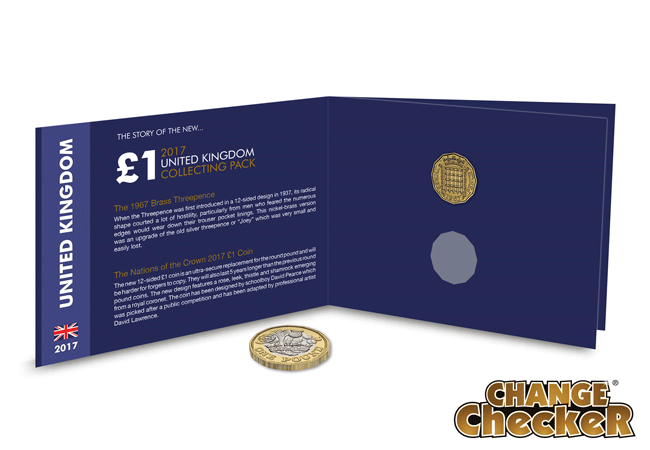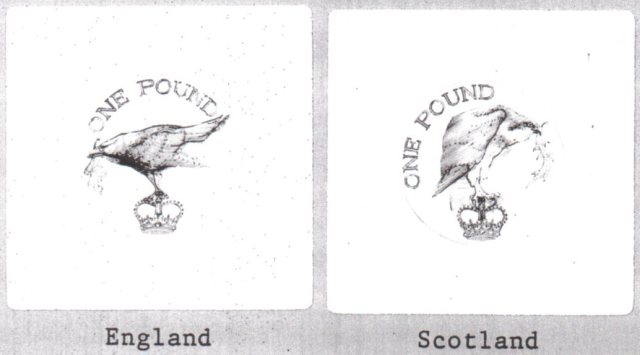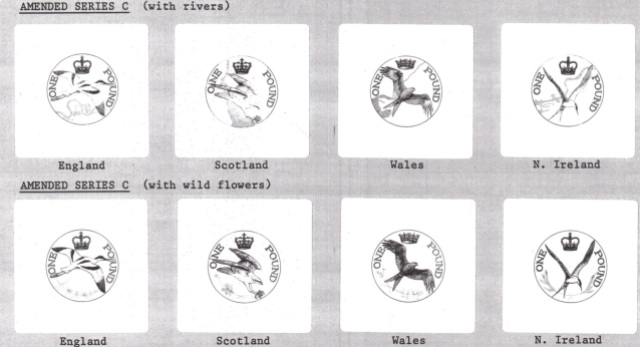Posts Tagged ‘One Pound’
The Pound Coin and the rejected bird designs
25 years ago The Royal Mint decided to explore the possibility of creating a new series of reverse designs on the £1 coins to represent the four constituent parts of the United Kingdom .
Selected artists were invited to submit designs that should have a common theme and a unified style, but they were allowed a free hand in the choice of subject matter.
In a 1992 edition of ‘The Medal’ magazine, Marina Warner – a writer and member of the Royal Mint Advisory Committee – revealed that there were two finalists in the competition and wrote “Designer 9 produced an elegant series of sketches that were in positive danger of producing pleasure“.
The designs, by Mary Milner Dickens, featured the avocet for England, the osprey for Scotland, the red kite for Wales, and the roseate tern for Northern Ireland. Each had been close to extinction earlier in the century but had made a successful breeding return. Designer 8, meanwhile, “submitted a series of ploddingly traditional heraldic schemes“.
The first sketches show each national bird perched on a crown. The bird representing England appears to be a crow, but this was changed to an avocet in subsequent sketches.
Later sketches show each bird sitting on a national plant (oak branch, thistle, leek and flax respectively) and another variation shows the same designs but with a crown separating the words “ONE POUND”.
In later designs Mary Milner Dickens showed the birds in flight. One version shows each bird above a map of a pertinent national river, while the other variation shows essentially the same design but with the rivers replaced by flowers. Both versions depict a relevant national crown for each design, rather than simply portraying St Edward’s crown in each case.
However, there was a conflict of interest.
In 1993, Norman Lamont (Chancellor of the Exchequer and ex-official Master of The Royal Mint) caused dissent amongst The Royal Mint Advisory committee by overriding a decision usually made by them. In a statement by Mr Anthony Nelson (Economic Secretary at the Treasury) he told members that Mr. Lamont “just does not like birds” and was consequently opting for the heraldic design.
This decision sparked outrage leading to the resignation of Marina Warner, a member of the Committee at the time, who accused the Chancellor and his officials of rejecting the designs because of the idea of innovation itself in the iconography of the coinage.
The Royal Mint documents do not reveal the details of the discussions, stating only that there was a “full and frank” discussion.
So instead of the 1994-1997 heraldic £1 coins designed by Norman Sillman (designer 8) that we are so familiar with today, we could have had four completely different £1 designs in our change.

The heraldic £1 coin designs from 1994-1997 that represent the four constituent parts of the UK designed by Norman Sillman
At the time Mary Milner Dickens had already designed the 1992 EC 50p and she later went on to create the reverse designs of the Libraries 50p in 2000 and the Queen Victoria £5 in 2001.

Mary Milner Dickens also designed the 1992 UK EC Presidency, 2000 Public Libraries 50p and the 2014 Queen Anne £5
As the 1990’s progressed, the designs of commemorative 50p and £2 coins became more boldly innovative. The national bridges that featured on £1 coins between 2004 and 2007 were distinctly non-heraldic – and no-one objected.
Credit: First published in Coin News – this article was written by Philip McLoughlin and researched by Dutch numismatist Niels van Schendel.
Why the 2016 £1 coin is about to become the latest coin collecting myth
The Royal Mint have confirmed that more than half a billion of the new £1 coins that have been released into circulation will be dated 2016.
But you may have also seen in the news that if you find one with a 2016 date, it could be one of the handful of ‘uniquely flawed coins’ and may be worth £250.
Unfortunately that isn’t the case.
Coins are typically struck with dies with that year’s date on, and as 1.5 billion new coins were required for the launch of the new 12-sided £1 coin, The Royal Mint started striking them in March 2016. That means that all of the new 12-sided £1 coins that were produced last year will have the 2016 date on them.
Will the 2016 12-sided £1 coins be rare?
In short, no. With half a billion 2016 dated £1 coins in circulation, they should be relatively easy to get hold of. In fact, we are yet to see someone who has found a 2017 dated £1 in their change.

Over half a billion 2016 dated £1 coins have been released into circulation. So far the only 2017 dated £1 coins we have seen are the Brilliant Uncirculated collector versions.
If we take a look back to the mintage figures in 1983 when the £1 coin was first introduced, in total 443,053,510 of the Royal Arms £1 coin were struck for circulation that year. That’s a little less than the amount of 2016 dated £1 coins and nearly 3 times less than the total amount of of the new coins struck for launch.
Considering 1983 was a time without contactless payments and when cash was the most used method of payment, 443,053,510 seems a relatively small amount in comparison to the 1.5 billion required for the new 12-sided £1 coin launch.
1997 Maklouf ‘Queen with a Necklace’ £2
You may remember the collecting frenzy that the ‘Queen with a Necklace’ £2 coin caused in 1998 when the brand new bi-metallic coin was introduced into circulation.
The ‘Queen with a Necklace’ £2 has an enduring legacy in the collecting world as the very first bi-metallic £2 coins issued just prior to the Queen’s portrait change in 1998. This meant that the older portrait by Raphael Maklouf was only used for one year: 1997. His version featured Queen Elizabeth II wearing a necklace, which is how the nickname was derived.
When the portrait change was announced, the new £2 coins were snapped up by collectors believing them to be a future rarity. As it turned out, a mintage of nearly 14 million means the ‘Queen with a Necklace’ £2 is not one of the rarest coins in circulation. Nevertheless, with only one year of issue, it still holds an undeniable interest for collectors.
An undeniable interest for collectors.
And the same can be said for the 2016 dated £1 coin. Although the £1 is in no way a rarity, first year of issue coins are always more sought after in years to come. As the new coin is Britain’s first 12-sided £1 and it is the first specification change to our £1 coin in more than 3 decades, the new 2016 dated £1 should hold a significant place in any coin collection.
#foundapound
To celebrate the release of the new 12-sided £1 coin, we’re giving away FIVE ‘Nations of the Crown’ Silver Proof 12-Sided £1 Coins!
For your chance to WIN a Silver Proof £1, all you need to do is find one of the new 12-sided £1 coins in your change…
Post a photo via Facebook, Twitter or Instagram using the hashtag #foundapound and the location you found your first £1 coin.
We’ll then choose 5 winners at random on the 10th April.
It’s really that easy – so good luck and get posting! #foundapound
50 years in the making – from 3d to £1: the story behind the new £1 coin
In just a few weeks, Britain’s one pound coin will undergo a major makeover. The familiar round pound will change to become bi-metallic and 12-sided and will also have several new security features. But the shape of this new £1 coin is actually a throwback to the thrup’nny bit – an old favourite from the pre-decimal era.
The 12-sided threepenny is fondly remembered for its individuality. There was quite literally nothing like it before, and it holds the proud title of Britain’s first non-circular coin.
But, of course, it’s not the first major change in the nation’s £1.
I’ve taken a look back at some of the key changes for Britain’s coinage over the last 50 years to welcome the brand new 12-sided £1 coin, when it is issued on 28th March.
The 28th March 2017 is sure to become a historic day as we welcome the new coin which has been billed to become the most secure circulating coin in the world. This will be the first specification change to our £1 coin in more than 3 decades.
But the Thrup’nny Bit deserves recognition for being the inspiration behind our new £1 coin which is sure to become a collecting sensation. The Thrup’nny Bit was eventually withdrawn from circulation in 1971 after the introduction of decimal coinage which didn’t include Three Pence as a denomination. However, its legacy lives on, and is still widely regarded as one of the most iconic coins in British history.
 The Story of the new £1 Collector’s Pack
The Story of the new £1 Collector’s Pack
Click here to secure the ‘Story of the £1 Collector Pack’ which has space for you to house the new 12-sided £1 coin once you find it in your change, alongside the UK Brass 12-Sided Threepence Coin.






